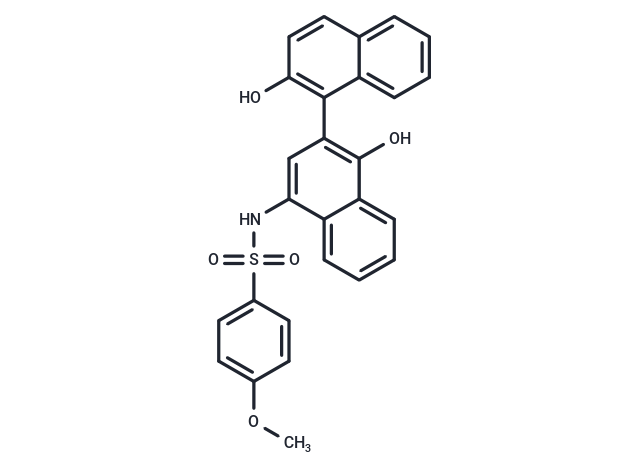Shopping Cart
- Remove All
 Your shopping cart is currently empty
Your shopping cart is currently empty

C188-9 (TTI-101) is a Stat3 inhibitor with an IC50 of 4-7 μM.

| Pack Size | Price | Availability | Quantity |
|---|---|---|---|
| 1 mg | $38 | In Stock | |
| 2 mg | $54 | In Stock | |
| 5 mg | $89 | In Stock | |
| 10 mg | $125 | In Stock | |
| 25 mg | $263 | In Stock | |
| 50 mg | $418 | In Stock | |
| 100 mg | $625 | In Stock | |
| 500 mg | $1,330 | Backorder | |
| 1 mL x 10 mM (in DMSO) | $97 | In Stock |
| Description | C188-9 (TTI-101) is a Stat3 inhibitor with an IC50 of 4-7 μM. |
| Targets&IC50 | STAT3:4-7 μM |
| In vitro | For apoptosis studies, AML cell lines and primary samples are treated for 24 hours with C188-9, then apoptotic cells are quantified by FACS analysis for annexin V-labeled cells. The EC50s for apoptosis induction are quite variable, ranging from 6 μM to over 50 μM |
| In vivo | In an analysis of approximately 13,528 discernible genes, C188 influences the expression of 37 gene transcripts (17 downregulated and 20 upregulated, false discovery rate (fdr)<0.01, fold change≥1.5), including 7 known targets of STAT3. Conversely, C188-9 exhibits a broader impact, modifying the expression of 384 genes related to oncogenesis (95 down- and 289 up-regulated), 76 of which are regulated by STAT3 (38 down-regulated and 38 up-regulated). Notably, C188-9 treatment downregulates 24 out of 38 genes (63%) previously identified as upregulated by STAT3. Furthermore, C188-9 downregulates an additional 10 genes (fdr <0.01, fold change≥1.5) known to be upregulated by STAT1, suggesting that 83.3% (40 out of 48) of the genes downregulated by C188-9 are positively regulated by STAT1. This includes sixteen genes co-regulated by both STAT3 and STAT1. The findings suggest that C188-9's modulation of gene transcript levels in head and neck squamous cell carcinoma (HNSCC) tumors may be attributed to its dual influence on STAT3 and STAT1 pathways. |
| Alias | TTI-101 |
| Molecular Weight | 471.52 |
| Formula | C27H21NO5S |
| Cas No. | 432001-19-9 |
| Smiles | COc1ccc(cc1)S(=O)(=O)Nc1cc(c(O)c2ccccc12)-c1c(O)ccc2ccccc12 |
| Relative Density. | 1.416 g/cm3 (Predicted) |
| Storage | Powder: -20°C for 3 years | In solvent: -80°C for 1 year | Shipping with blue ice. | ||||||||||||||||||||
| Solubility Information | DMSO: 60 mg/mL (127.25 mM), Sonication is recommended. 10% DMSO+40% PEG300+5% Tween 80+45% Saline: 6 mg/mL (12.72 mM), In vivo: Please add the solvents sequentially, clarifying the solution as much as possible before adding the next one. Dissolve by heating and/or sonication if necessary. Working solution is recommended to be prepared and used immediately. | ||||||||||||||||||||
Solution Preparation Table | |||||||||||||||||||||
DMSO
| |||||||||||||||||||||

Copyright © 2015-2025 TargetMol Chemicals Inc. All Rights Reserved.